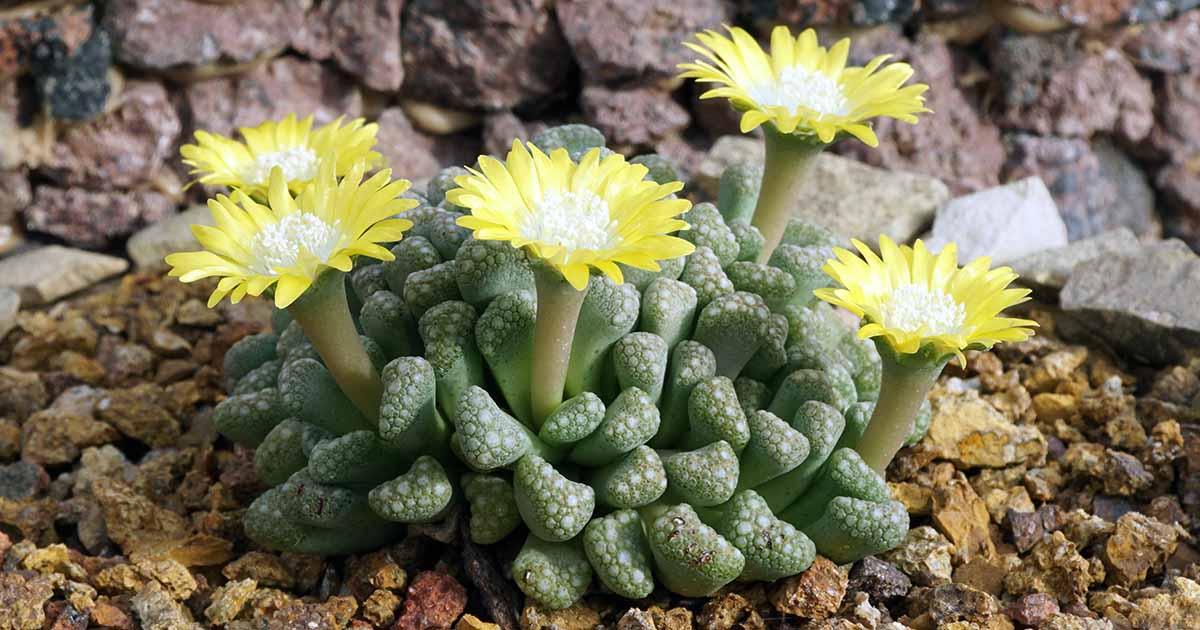Our guide to growing concrete leaf plants gives an overview of the Titanopsis genus and how to care for these unique succulents.
In this article, we will focus on titanopsis jewel plants. Here’s what I’ll cover:
T. hugo-schlechteri is native to Namibia and South Africa, where this mesemb grows in desert or dry shrubland – either in limestone flats or in limestone soils covered with red sand.


They blend in with the rocky environment, making them hard to spot until their winter blooms appear.
Known by the common names jewel plant and living rock, this succulent species is a member of the Titanopsis genus along with three other species, often referred to as concrete leaf plants.
Quick Look
Common name(s): Jewel plant, living rock
Plant type: Evergreen succulent
Hardiness (USDA Zone): 8b-11b (outdoors)
Native to: Namibia, South Africa
Bloom time / season: Winter
Exposure: Full sun, some light shade in summer
Soil type: Gritty succulent and cactus growing medium
Soil pH: 6.5-8.5, slightly acidic to alkaline
Time to maturity: 2 years
Mature size: 4-6 inches wide x 2 inches high
Best uses: Houseplant, xeriscape
Taxonomy
Family: Aizoaceae
Subfamily: Ruschioideae
Genus: Titanopsis
Species: Hugo-schlechteri
This genus is a member of the Aizoaceae or ice plant family, also called the fig marigold family.
This family includes numerous other succulents, many of which are also mimicry plants – botanical species which have evolved to hide their plant-like attributes.


Some of these mesembs include lithops (Lithops spp.), baby toes (Fenestraria rhopalophylla), ice plant (Delosperma lehmannii), split rock (Pleiospilos nelii), and tiger jaws (Faucaria spp.).
A recipient of the Royal Horticultural Society’s Award of Garden Merit in 2012, this species makes an excellent houseplant and can also be cultivated outdoors year-round in USDA Hardiness Zones 8b to 11b.
How to Grow
If you have a sunny, south-facing windowsill or a good grow light, jewel plant will be an excellent houseplant.


Outdoors, it’ll need protection from too much rain, and looks beautiful in a xeriscape.
Let’s go over what this plant needs to thrive:
Soil
Jewel plants need a potting medium with excellent drainage.
This medium should be made up of around 85 percent mineral content and 15 percent organic matter, with a pH between 6.5 to 8.5.
This is a higher percentage of grit than is in most commercial cactus and succulent potting soils, so it’s best to make a mix of your own.
I like to start with Rosy Soil’s Houseplant Mix for the organic matter.


Rosy Soil Houseplant Mix
You can find four- or eight-quart bags of Rosy Soil Houseplant Mix available via Walmart.
You can use a variety of materials for the mineral grit, including pumice, lava gravel, coarse sand, or limestone gravel.
Light
This titanopsis needs full sun – that means six to eight hours of direct sunlight a day. Indoors, a bright south-facing window, grow lights, or a combination of the two will work.

